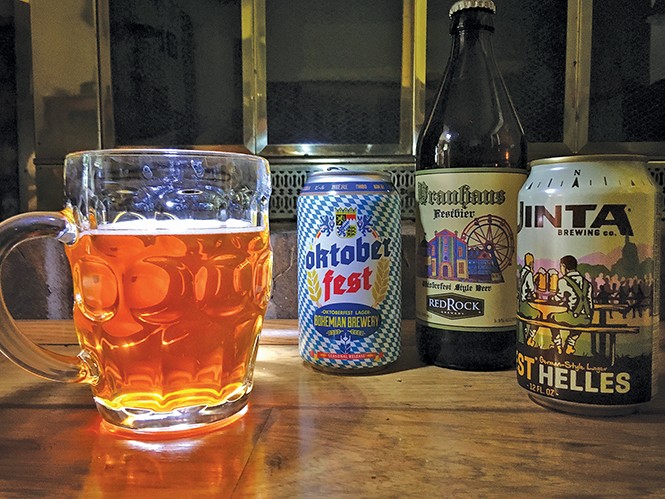Brewing beer has always been a very serious and highly regulated part of life in Germany. It seems like there are more laws pertaining to the brewing of German beer than there are actual beers in some regions of the world. One of my favorite German styles is the Bavarian Marzenbier (pronounced Maerzen-beer). By law, it can be brewed no later than March. The special recipe of this style allows it to withstand the long lagering process—cool fermentation—for its debut in early autumn. The timing of its public release makes it the beer of choice for fall celebrations, including the beloved Oktoberfest. If you'd like to know what all the fuss is about, I've provided three local examples that will keep lederhosen and dirndls in mind, if not in body.
Red Rock Brauhaus Festbier has the color of deep saturated copper when backlit through my window, with some golden highlights. The nose is rich with caramel and earthy malts. A flash of baked apple pops through in the middle, along with a soft, herbal aroma at the end of the sniff. On the tongue, caramel coats the every taste bud while toasted bread follows close behind. Subtle vanilla bean and Nutella flavors begin to emerge next, adding complexity to an already rich base. The end brings along grassy and herbal hops to balance out the sweetness, adding depth along with bitters. The alcohol is barely noticeable at 5.5 percent ABV.
Overall: This beer is plush and luxurious; examples such as this have made me a huge fan of the marzen style. It manages to stay clean while still being a malt-forward lager. This will be in my fridge throughout autumn.
Bohemian Oktoberfest pours a bright, clear golden-amber hue. The nose brings biscuits, caramelized sugars, roasted nuts and grass. The first sip begins with toasted grains, caramel and some bready notes; subtle nuttiness, along with some vague orchard fruits, tease the front of the tongue. A floral and grassy hop bitterness causes the sweeter aspects of the beer to make a sharp turn, providing a nice herbal counterbalance to the malt bill. For a 4 percent ABV lager, it weighs on the tongue like a slightly bigger brew.
Overall: This is a properly constructed marzen for sure, with a clean malt bill augmented by a restrained noble hop presence. Marzen fans fans should keep their eyes peeled for this clean-tasting, extremely drinkable malt-forward seasonal lager. It's a refreshing pleasure.
Uinta Helles Festbier: This seasonal offering pours a clear honey orange, with a foamy eggshell-colored head that settles to a small cap on top of the beer. A deep whiff offers malty and grainy scents, with a good dose of herbal hops and grass. The taste is much the same, plus a bit of burnt caramel and honey that transitions into toasted nuts and herbs. There's a subtle apple fruitiness as well. On the back end, you'll find an ample amount of noble hop bitterness to tie it all together; keeping it from being overly sweet. Its 5.5 percent ABV is more freshening than boozy.
Overall: Though not technically a Marzebier, the German Helles-style lager is a close cousin to the style. While it lacks some of the more caramel-forward aspects of a marzen, it offers a slightly drier palate for those looking for less sweetness.
These are all seasonal beers, designed for the crisp fall air. Do yourself a favor and enjoy these now, while they're fresh and bright.
As always, prost!
More by Mike Riedel
-
Salt Lake Brewing Black Sunshine and Saltfire A Series of Singularities
Two craft brews that'll put you in your happy place.
- Apr 17, 2024
-
Epic Utah Margarita and Shades Citrus Circus
Dreary days are chased away as the flavors of summer come early.
- Apr 10, 2024
-
Bewilder Big Crispy and Red Rock Swan Lake
Tasting a pair of un-lager-like lagers
- Apr 3, 2024
- More »





